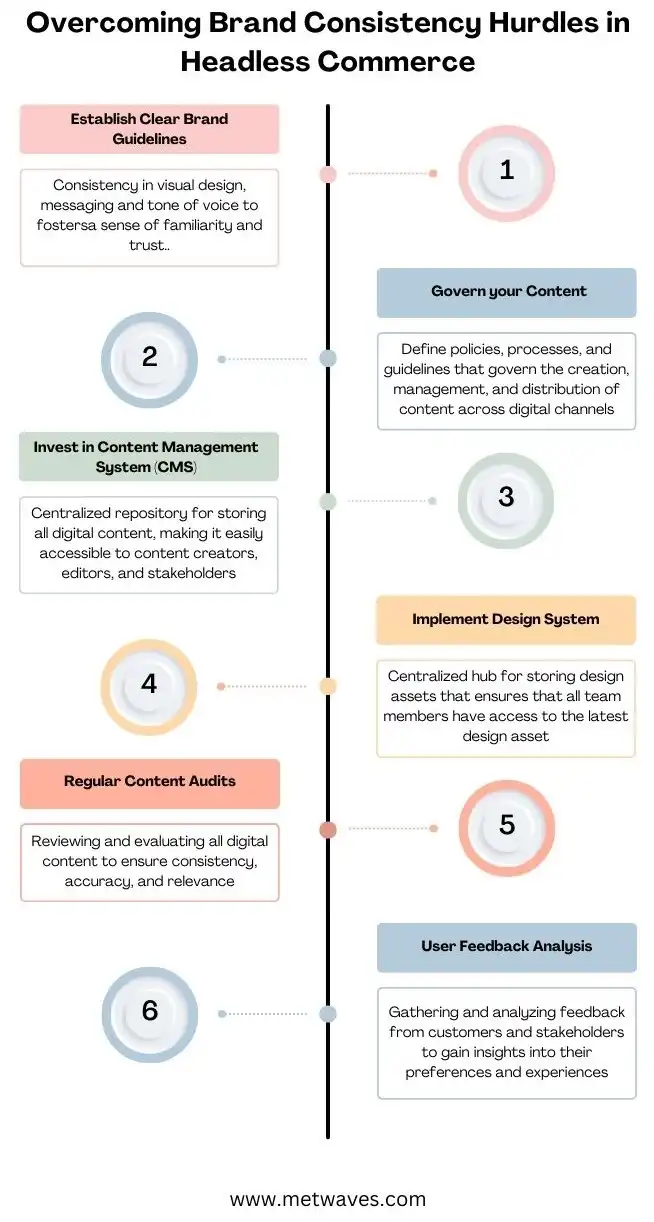Headless commerce is becoming an increasingly popular choice for businesses looking to deliver seamless, personalized, and engaging digital experiences to their customers. eCommerce stores and enterprise brands are reaching out to this latest buzz in the online retail world, to scale or expand their e-commerce operations.
Striking the Right Chord...
Transitioning from traditional, monolithic architectures to a headless framework comes with its fair share of challenges. Biggest challenge lies around maintaining consistency across different channels, managing disparate systems and APIs, and ensuring a seamless customer experience.
In this article, we will specifically talk about how ensuring a unified brand experience in headless commerce can be challenge for businesses in an increasingly fragmented digital landscape. And explore practical strategies for ensuring brand consistency in headless commerce implementations.
To begin with, let's see how brand inconsistency can creep in Headless commerce:
Think of your favorite store – it has a certain look, feel, and way of talking to you, right?
Now, imagine if this store decided to sell its products in many different places, like on a website, a mobile app, and maybe even through voice commands on your smart speaker. In regular stores, it's easier to keep everything looking and sounding the same because it's all connected.
But with headless commerce, it's like the store's different parts are spread out. So, if the website looks different from the mobile app, and both are different from what you hear on your smart speaker, it might be confusing. That's where the problem of branding inconsistency comes in – the way the store looks, talks, and feels isn't the same everywhere. It's like getting a different vibe in each part of the store.

Strategies for Tackling Brand Consistency Challenges
Whether your customers are browsing a website, using a mobile app, or engaging on social media, they all expect a cohesive and unified brand experience. Basically, it means there must be a consistency in visual design, messaging and tone of voice to foster a sense of familiarity and trust.
So, what we can do about it? Here are few steps that will help teams to maintain brand consistency.
- Create centralized brand guidelines for maintaining consistency across all touchpoints in a headless commerce environment. These guidelines should encompass key elements of brand identity, including logos, colors, typography, imagery, and messaging.
- Use SVGs for scalable and resolution-independent graphics that maintain crispness and clarity across different devices and screen densities. SVGs allow businesses to create icons, logos, and illustrations that scale seamlessly without loss of quality, ensuring consistency in visual design elements.
- Implement component-based design systems that provide reusable UI components, patterns, and styles for building consistent user interfaces across different front-end applications and channels. By standardizing design elements and components, businesses ensure coherence and consistency in the digital experience.
- Create Style guides that outlines the rules and specifications for visual design elements, such as color palettes, typography, iconography, and UI components.
In online shopping, it's important for companies to keep their messages and how they sound consistent. But it can be tough because they have to manage lots of different places where their messages go. This is where content governance comes in.
Content governance refers to the framework of policies, processes, and guidelines that govern the creation, management, and distribution of content across digital channels.
What can kind of processes or guidelines can be included in the Content Governance framework. Let's check out:
- Define approval workflows that govern the review and approval process for content creation and distribution. Define roles and permissions for content creators, editors, and stakeholders, and establish clear criteria for content quality, accuracy, and compliance with brand guidelines.
- Define editorial guidelines, style standards, and brand voice principles to ensure consistency in messaging across all channels and touchpoints. Provide training and resources to content creators and editors to ensure alignment with brand voice principles and messaging strategy.
- Invest in a centralized content management system (CMS) that will enable you to create, manage, and distribute content across different front-end applications and platforms. A headless CMS provides a single source of truth for content, facilitating collaboration, version control, and workflow automation. This point is covered in detail in next section.
Once you have created the blueprint of the framework and processes of your content governance, it's time to implement the Content Management System (CMS). A CMS is a software application that allows users to create, manage, and publish digital content, including text, images, videos, and other multimedia assets.
Let's now summarize how CMS plays a crucial role in managing and organizing content efficiently in headless commerce:
-
Centralized Content Repository
A CMS provides a centralized repository for storing all digital content, making it easily accessible to content creators, editors, and stakeholders. This centralization ensures that everyone works with the same set of content, reducing the risk of duplication, inconsistency, and version control issues.
-
Streamlined Content Creation and Publishing
With a CMS, content creation and publishing processes are streamlined and automated, enabling teams to create, edit, and publish content more efficiently. Content creators can use intuitive editing tools and templates to develop content, while editors can review and approve content before it goes live.
-
Version Control and Workflow Management
CMS platforms offer robust version control and workflow management capabilities, allowing teamsto track changes, revisions, and approvals throughout the content lifecycle. Content workflows can be customized to match the organization's approval processes, ensuring compliance with brand guidelines and editorial standards.
-
Multi-channel Distribution
A modern CMS supports multi-channel distribution, enabling content to be published across various digital channels and touchpoints, including websites, mobile apps, social media platforms, and email newsletters.
-
Content Personalization and Targeting
Many CMS platforms offer built-in features for content personalization and targeting, allowing businesses to deliver relevant and personalized experiences to individual users based on their preferences, behaviors, and demographics. Personalized content can help you enhance engagement, drive conversion, and foster customer loyalty.
Examples of CMS Platforms:
Once you have decided typography, color palettes, and iconography across all digital touchpoints, it's now time to implement define design guidelines and style standards.Design Collaboration Platforms play a vital role in ensuring efficient collaboration and enforcement of design standards. These platforms provide a centralized environment for designers, developers, and stakeholders to collaborate, share assets, and maintain consistency in design elements.
Let's now checkout the key points on how Design Collaboration Platform ensures adherence to brand guidelines, and streamlining the design process:
-
Centralized Design Hub
Design Collaboration Platforms serve as a centralized hub for storing design assets, including graphics, images, icons, and templates. This centralization ensures that all team members have access to the latest design assets, reducing the risk of using outdated or incorrect assets in their work.
-
Collaborative Workspaces
These platforms provide collaborative workspaces where designers can work together in real-time, share ideas, provide feedback, and collaborate on design projects. Features such as commenting, annotations, and version history tracking facilitate communication and collaboration among team members.
-
Version Control and Asset Management
Design Collaboration Platforms offer robust version control and asset management capabilities, allowing designers to track changes, revisions, and updates to design files. Version control ensures that everyone is working with the latest version of design assets, minimizing the risk of inconsistency and confusion.
-
Feedback and Approval Workflows
These platforms enable streamlined feedback and approval workflows, allowing stakeholders to review design concepts, provide feedback, and approve designs in a structured manner. Automated notifications and task assignments help keep the review process organized and efficient.
-
Integration with Design Tools
Design Collaboration Platforms often integrate seamlessly with popular design tools such as InVision, Sketch, and Figma, allowing designers to work in their preferred tools while syncing changes to the collaboration platform in real-time. This integration enhances workflow efficiency and productivity.
Examples of Design Collaboration Platforms:
Maintaining brand consistency and effectiveness in headless commerce requires an ongoing effort of regularly observing and assessing various aspects of a business's digital presence, including content, user interactions, and performance metrics.
Staying vigilant and proactive in identifying any deviations from brand standards, user expectations, or desired outcomes is the key. Address any issues or opportunity promptly to maintain brand consistency and effectiveness.
Regular content audits involve systematically reviewing and evaluating all digital content to ensure consistency, accuracy, and relevance. Content audits help identify outdated, redundant, or inconsistent content that may detract from the overall brand experience. In addition, it also points out at areas for improvement.
User feedback analysis involves gathering and analyzing feedback from customers and stakeholders to gain insights into their preferences, perceptions, and experiences. This feedback can be collected through various channels, including surveys, reviews, social media, and customer support interactions.
By analyzing user feedback, businesses can identify trends, patterns, and pain points that may impact brand consistency.
In the realm of headless commerce, where the separation of front-end and back-end enables unparalleled flexibility and customization, maintaining brand consistency is paramount for building trust, loyalty, and recognition among customers.
By implementing centralized brand guidelines, style guides, and design systems, leveraging tools and technologies for enforcement, and embracing a culture of continuous monitoring and optimization, businesses can ensure coherence and consistency in the digital experience across all channels and touchpoints.

